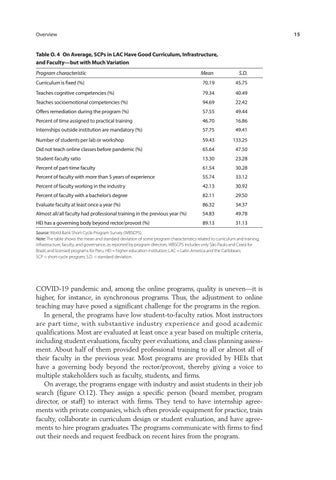15
Overview
Table O. 4 On Average, SCPs in LAC Have Good Curriculum, Infrastructure, and Faculty—but with Much Variation Program characteristic
Mean
S.D.
Curriculum is fixed (%)
70.19
45.75
Teaches cognitive competencies (%)
79.34
40.49
Teaches socioemotional competencies (%)
94.69
22.42
Offers remediation during the program (%)
57.55
49.44
Percent of time assigned to practical training
46.70
16.86
Internships outside institution are mandatory (%)
57.75
49.41
Number of students per lab or workshop
59.43
133.25
Did not teach online classes before pandemic (%)
65.64
47.50
Student-faculty ratio
13.30
23.28
Percent of part-time faculty
61.54
30.28
Percent of faculty with more than 5 years of experience
55.74
33.12
Percent of faculty working in the industry
42.13
30.92
Percent of faculty with a bachelor’s degree
82.11
29.50
Evaluate faculty at least once a year (%)
86.32
34.37
Almost all/all faculty had professional training in the previous year (%)
54.83
49.78
HEI has a governing body beyond rector/provost (%)
89.13
31.13
Source: World Bank Short-Cycle Program Survey (WBSCPS). Note: The table shows the mean and standard deviation of some program characteristics related to curriculum and training, infrastructure, faculty, and governance, as reported by program directors. WBSCPS includes only São Paulo and Ceará for Brazil, and licensed programs for Peru. HEI = higher education institution; LAC = Latin America and the Caribbean; SCP = short-cycle program; S.D. = standard deviation.
COVID-19 pandemic and, among the online programs, quality is uneven—it is higher, for instance, in synchronous programs. Thus, the adjustment to online teaching may have posed a significant challenge for the programs in the region. In general, the programs have low student-to-faculty ratios. Most instructors are part time, with substantive industry experience and good academic qualifications. Most are evaluated at least once a year based on multiple criteria, including student evaluations, faculty peer evaluations, and class planning assessment. About half of them provided professional training to all or almost all of their faculty in the previous year. Most programs are provided by HEIs that have a governing body beyond the rector/provost, thereby giving a voice to multiple stakeholders such as faculty, students, and firms. On average, the programs engage with industry and assist students in their job search (figure O.12). They assign a specific person (board member, program director, or staff) to interact with firms. They tend to have internship agreements with private companies, which often provide equipment for practice, train faculty, collaborate in curriculum design or student evaluation, and have agreements to hire program graduates. The programs communicate with firms to find out their needs and request feedback on recent hires from the program.

